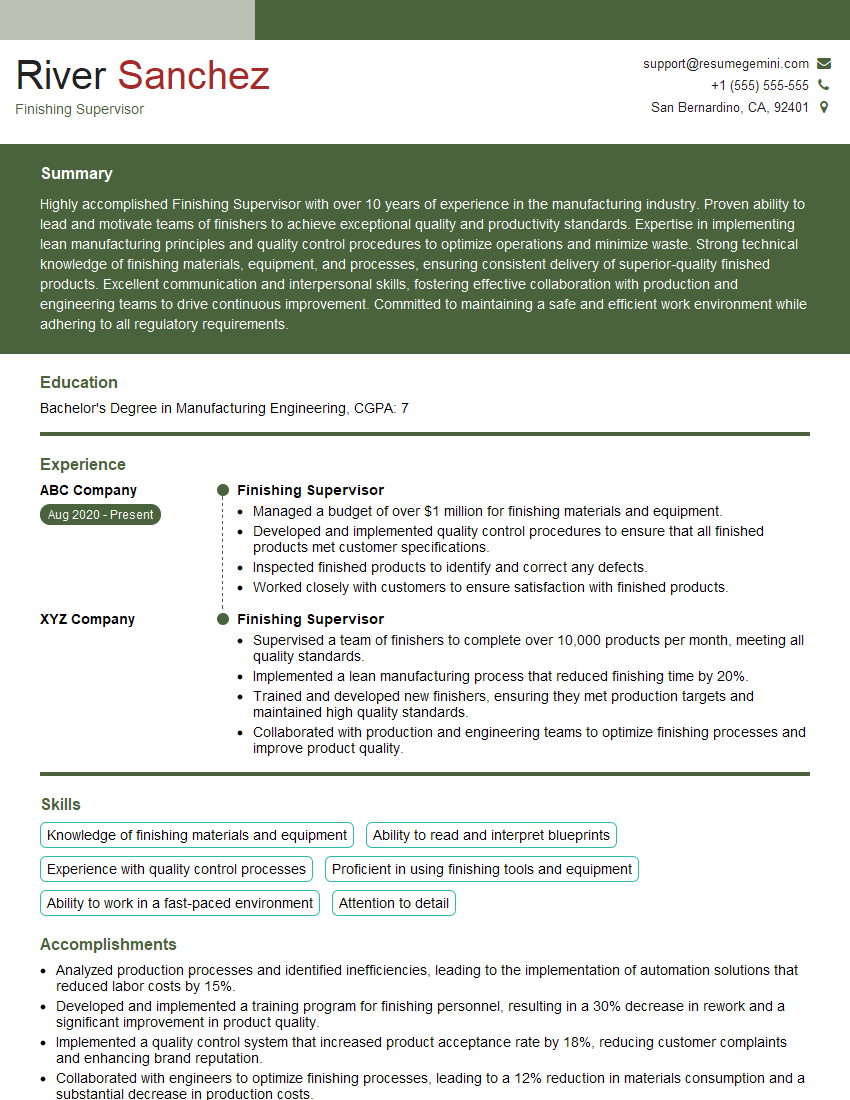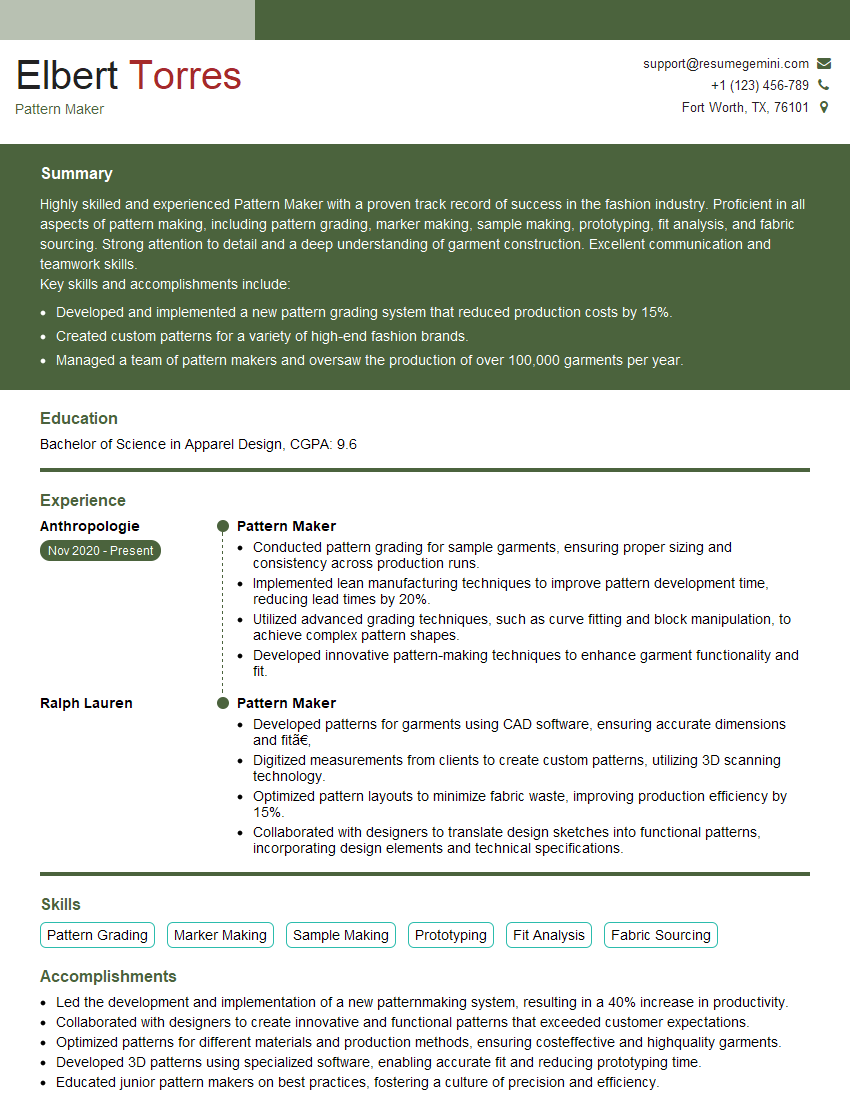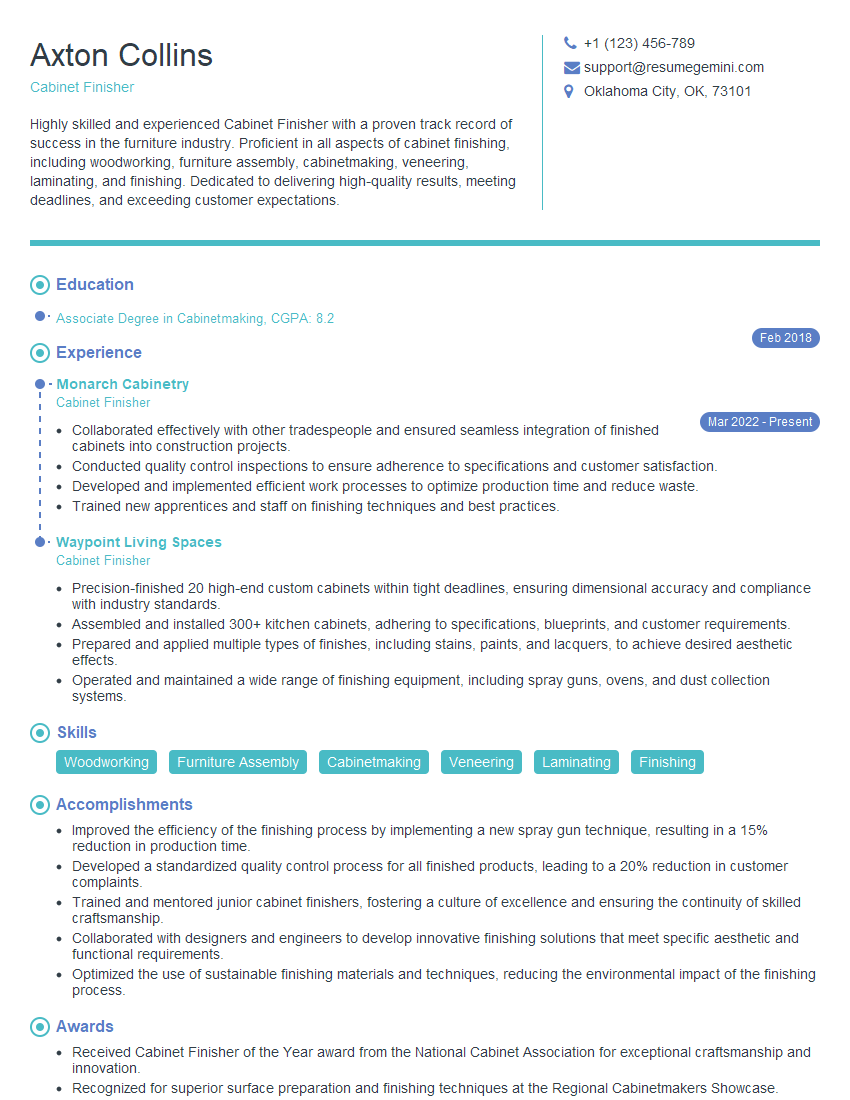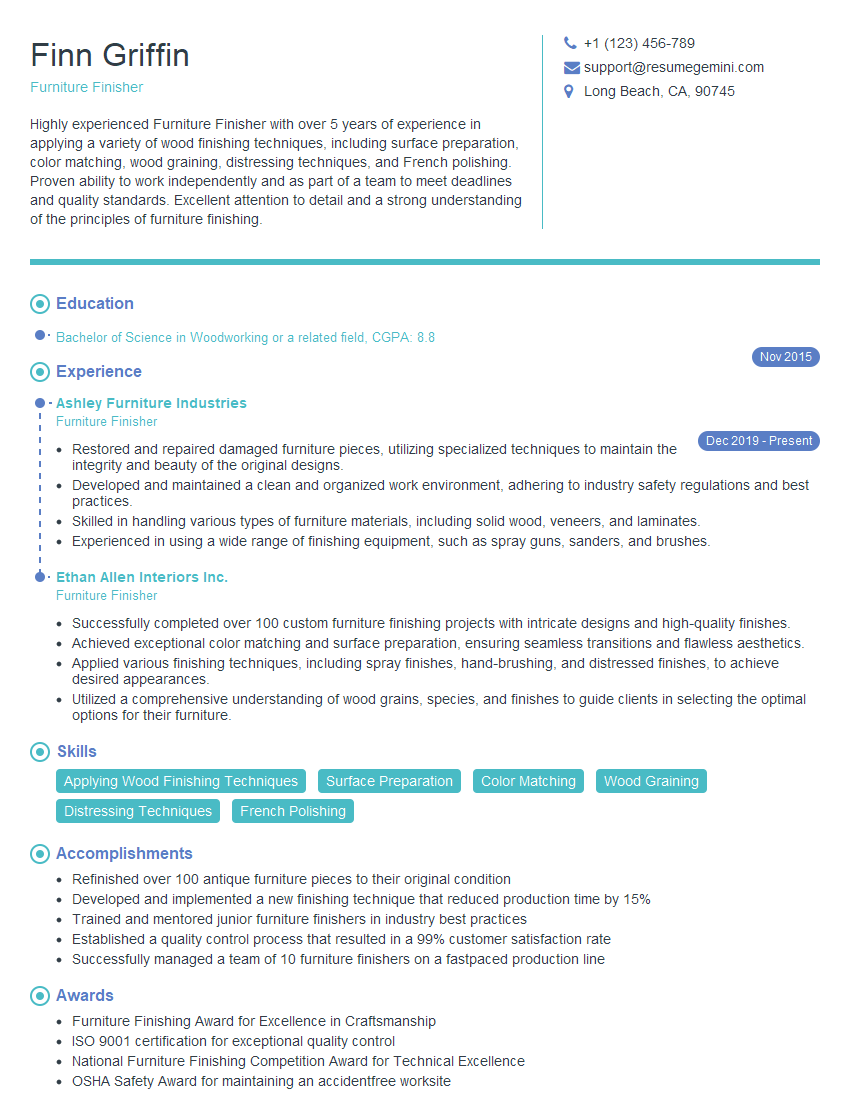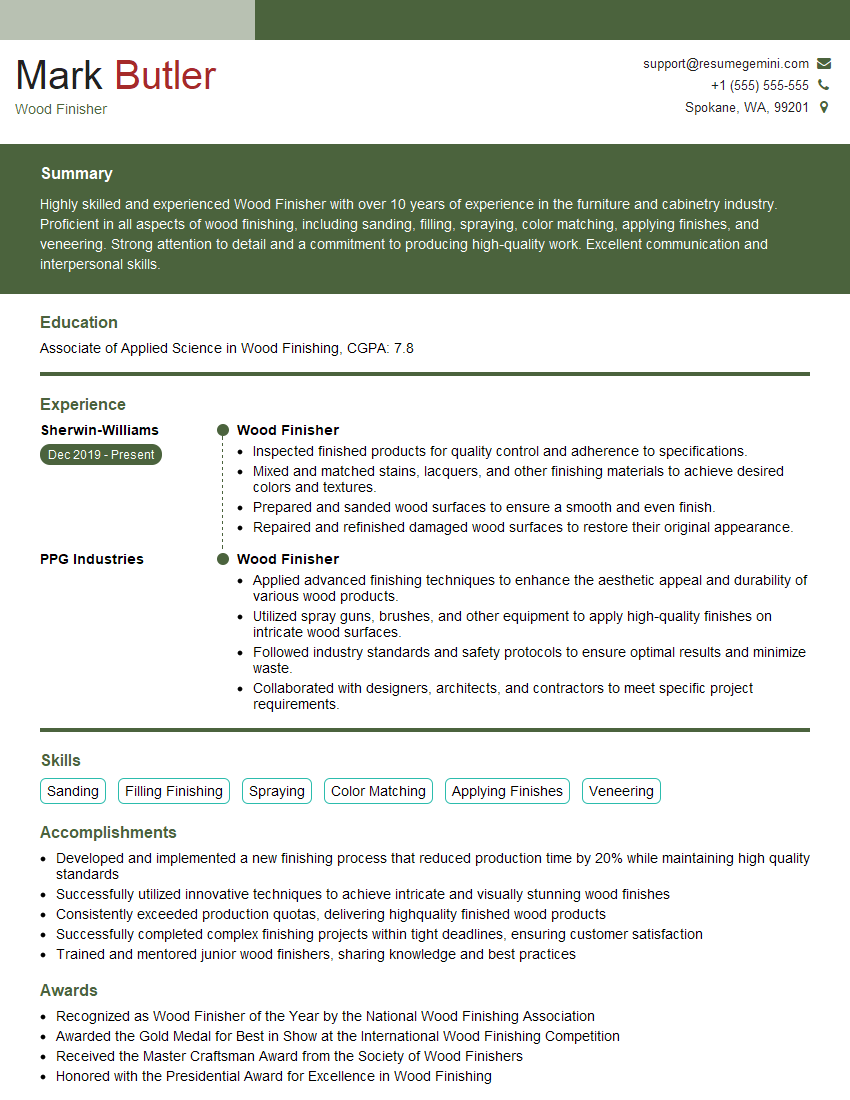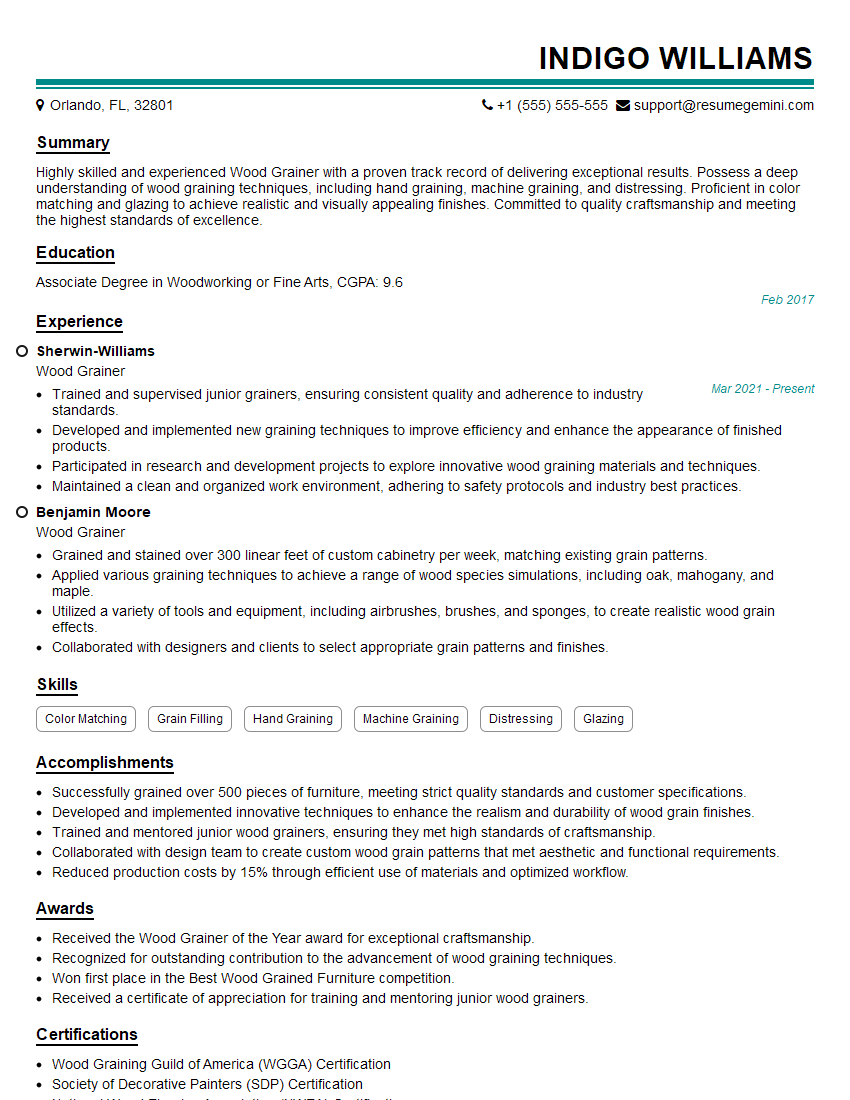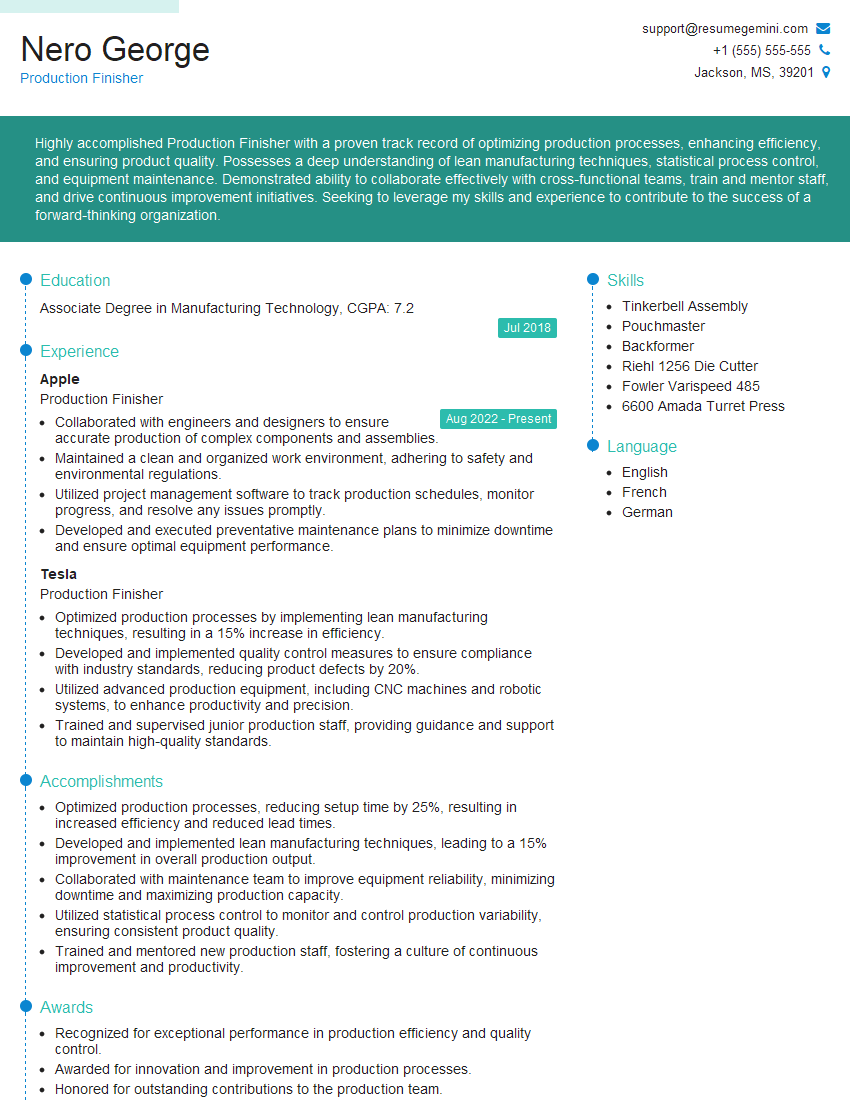Interviews are opportunities to demonstrate your expertise, and this guide is here to help you shine. Explore the essential Graining interview questions that employers frequently ask, paired with strategies for crafting responses that set you apart from the competition.
Questions Asked in Graining Interview
Q 1. Explain the difference between water-based and oil-based graining stains.
The primary difference between water-based and oil-based graining stains lies in their composition, application, and final finish. Water-based stains are typically easier to clean up with soap and water, dry faster, and have lower VOCs (Volatile Organic Compounds), making them a more environmentally friendly choice. However, they can sometimes be less vibrant and may require multiple coats to achieve the desired depth of color. Oil-based stains, on the other hand, offer richer, more intense colors and tend to penetrate the surface more deeply. They also provide a more durable finish, resistant to scratches and wear. However, oil-based stains require mineral spirits or solvents for cleanup and have a longer drying time, often emitting stronger fumes during application.
Think of it like this: water-based stains are like watercolor paints – lighter, quicker to dry, and easier to control, while oil-based stains are more like oil paints – richer, more intense, but requiring more care and patience.
Q 2. Describe your experience with various graining tools (e.g., combs, sponges, brushes).
My experience spans a wide range of graining tools, each suited for different effects. Combs, for example, are excellent for creating fine, linear grain patterns, especially mimicking woods like oak or pine. I’ve used various combs with different spacing and tooth shapes to achieve subtle variations in the grain. Sponges offer a more organic and textured approach, ideal for creating the irregular grain patterns of certain hardwoods or for achieving a more rustic, aged look. I frequently use sea sponges for their naturally irregular surface. Brushes, ranging from fine detail brushes to larger stippling brushes, provide control over the application of the graining stain and glaze, allowing for the creation of realistic knots, swirls, and other intricate details. I often use a combination of these tools, layering different techniques to achieve complexity and realism. For example, I might use a comb for the primary grain and then use a sponge to create subtle variations in color and texture.
One memorable project involved replicating the intricate grain of a highly figured mahogany. I used a specialized comb to create the primary grain lines and then meticulously used a fine brush to add the smaller, swirling details, finally using a soft sponge to blend the colors and create subtle variations in tone.
Q 3. How do you achieve a realistic wood grain effect on a non-wood surface?
Achieving a realistic wood grain effect on a non-wood surface requires careful preparation and application techniques. The key is to create the illusion of depth and texture. I start by preparing the surface meticulously – ensuring it’s smooth and primed with a suitable base coat. Then, I use a combination of stains and glazes to create the color variations and depth necessary to mimic the appearance of wood grain. This often involves creating a base color, then applying thin layers of darker glaze in a wood-grain pattern using the tools described earlier. The use of multiple glaze layers with varying tones and transparency adds depth and enhances the realism.
For example, when graining a metal surface to look like oak, I might first apply a light oak-toned base coat. Then, using a comb dipped in a darker glaze, I’d create the linear grain pattern of the oak. Finally, I’d use a slightly lighter glaze to highlight the raised portions of the grain, adding highlights and depth. A clear topcoat seals and protects the finished grain.
Q 4. What are the different types of wood grains you can replicate?
The range of wood grains I can replicate is extensive, encompassing a variety of species and styles. This includes common species like oak (with its characteristic linear grain), pine (with its more varied and often knobby grain), and maple (with its finer, more uniform grain). I also have experience replicating more exotic woods such as mahogany (known for its rich, swirling grain), cherry (with its reddish tones and straight grain), and walnut (with its dark, often highly figured grain). Beyond species-specific grains, I can also replicate various styles of wood grain, such as those found in antique furniture or highly figured veneers.
My proficiency extends beyond simply copying existing grains; I can also design and create unique, stylized grain patterns, offering creative flexibility to clients.
Q 5. Explain your process for color matching in graining.
Color matching in graining is a crucial aspect of achieving realism. My process involves a combination of techniques and tools. Firstly, I carefully examine the target wood or color sample to determine the base color and the color variations within the grain. Then, I use color charts and mixing guides to create the base color using the appropriate stains and glazes. I often use test patches on a separate surface to fine-tune the color blend before applying it to the main piece. I might create several small test areas, each with slight variations in color or opacity, to find the perfect match.
It’s a process of iterative refinement. I might start with a base color, add a glaze, and then assess the result. If needed, I’ll make adjustments – adding more color, adjusting the opacity of the glaze, or even experimenting with different glazes to achieve the desired depth and nuance.
Q 6. How do you prepare a surface for graining?
Surface preparation is paramount for a successful graining project. The surface must be clean, smooth, and properly primed. This typically involves cleaning the surface to remove any dust, dirt, or grease, then repairing any imperfections, such as scratches or dents. Next, I apply a primer or undercoat. The choice of primer depends on the surface material. For example, a different primer is used for wood versus metal or plaster. The primer ensures a uniform surface for the graining process and helps the stain adhere properly. Once the primer is dry, any minor imperfections are sanded down to create a smooth, level surface before the graining process begins.
Thorough preparation saves time and prevents issues later in the process. A poorly prepared surface can lead to uneven color application, poor adhesion, and an overall less realistic finish.
Q 7. Describe your experience with different types of glazing techniques.
My glazing techniques are diverse, depending on the desired effect. I regularly employ both wet-on-wet and wet-on-dry methods. Wet-on-wet involves applying successive layers of glaze before the previous layer is completely dry, allowing for blending and subtle color transitions. This technique is useful for creating soft, blended grain patterns. Wet-on-dry, on the other hand, involves allowing each layer to dry completely before applying the next, which helps create sharper contrasts and more defined grain lines. I frequently use a combination of both techniques in a single project to achieve a nuanced effect.
Beyond the basic wet-on-wet and wet-on-dry methods, I also employ various glaze application techniques, including stippling, dry brushing, and dragging, each producing unique textural effects. For example, stippling with a sponge creates a more rustic, uneven texture, while dragging a brush can create long, flowing grain patterns. The choice of technique depends entirely on the desired result.
Q 8. How do you handle imperfections or mistakes during the graining process?
Handling imperfections in graining is a crucial aspect of the process. It’s unrealistic to expect perfection every time, especially given the intricate nature of wood grain replication. My approach is multi-faceted. First, prevention is key. I meticulously prepare the surface, ensuring it’s smooth and evenly primed. This minimizes the chances of errors in the first place. If a mistake does occur, such as a poorly blended color or a stray brushstroke, I assess the severity. Minor imperfections can often be subtly corrected with careful blending using a soft brush and appropriate glaze. For larger errors, I might carefully scrape away the affected area and re-apply the grain, ensuring the surrounding area blends seamlessly. The key is patience and a keen eye for detail. Think of it like a painter correcting a minor flaw – sometimes a small touch-up is all that’s needed, other times, a more extensive repair is required.
For example, if a section of simulated oak grain appears too bold, I’ll lightly dampen a brush and gently soften the edges, diffusing the intensity. Conversely, if a walnut grain looks too faint, I might add a touch more color in the appropriate areas. The goal is not to erase the mistake, but to integrate it into the overall design so it remains inconspicuous.
Q 9. What are the common challenges in graining and how do you overcome them?
Common challenges in graining include achieving accurate color matching, maintaining consistent grain patterns, and dealing with uneven surfaces. Color matching requires a deep understanding of pigments and their interaction with the base coat. I use color charts and test swatches extensively to ensure a precise match to the desired wood species. Maintaining consistency is challenging because each stroke is unique. I address this by using consistent pressure, brush technique, and maintaining a regular rhythm throughout the process. Uneven surfaces can lead to inconsistent grain application. Therefore, I always prioritize surface preparation. This includes sanding, priming, and filling any imperfections before beginning the graining process. Think of it as building a strong foundation for a house – you can’t expect a perfect finish on a flawed base. Sometimes, I’ll use a specialized filler to level out particularly difficult surfaces.
Overcoming these challenges requires a combination of technical skill, patience, and attention to detail. I regularly practice my technique and stay updated on new tools and materials to refine my approach and efficiency.
Q 10. What safety precautions do you take when working with graining materials?
Safety is paramount in graining. The materials used, including paints, glazes, and solvents, can be hazardous if not handled properly. I always work in a well-ventilated area to minimize inhalation of fumes. I wear appropriate personal protective equipment (PPE), including a respirator mask to filter out particles and vapors, safety glasses to protect my eyes, and gloves to prevent skin irritation. Furthermore, I store all materials according to manufacturer instructions, keeping them away from ignition sources and out of reach of children. I also ensure proper disposal of waste materials to comply with environmental regulations.
For example, when working with strong solvents, I ensure adequate ventilation is present, ideally using an exhaust fan. I never mix solvents without consulting the safety data sheet (SDS) and follow the instructions carefully. Safety isn’t an afterthought; it’s an integral part of my process.
Q 11. Explain your experience with different graining patterns (e.g., oak, walnut, mahogany).
My experience encompasses a wide range of graining patterns. Oak, with its characteristic prominent medullary rays and open grain, requires a precise technique to replicate convincingly. I use various tools, including graining combs and brushes, to create the necessary texture and variation in tone. Walnut, known for its rich, often subtle, figure, necessitates a more delicate hand. My approach involves blending darker and lighter shades to emulate the depth and complexity found in genuine walnut. Mahogany, with its characteristic straight or interlocked grain and reddish-brown hues, demands precision in creating the linear pattern and achieving an even color distribution. Different brushes and techniques are employed to match each wood’s unique features. I find myself constantly researching and practicing to perfect my replication of these, and many other, wood species, ensuring the final result is convincingly realistic.
One project involved replicating the intricate grain of a rare African mahogany on a large-scale panel for a custom furniture piece. The client was very pleased with how convincingly realistic the graining looked.
Q 12. How do you maintain the quality and consistency of your graining work?
Maintaining quality and consistency is a continuous effort. It begins with meticulous preparation, using high-quality materials, and employing consistent techniques. I regularly calibrate my tools and maintain a clean workspace to prevent contamination or inconsistencies. I keep detailed notes of my color mixtures and techniques for each project, allowing me to reproduce results consistently. Regular self-assessment and critique of my work are vital, as it helps identify areas for improvement and refine my process.
For example, I developed a standardized system for mixing my glazes, using precisely measured amounts of pigment and binder to guarantee uniformity. This ensures that every application of a particular wood species achieves a consistently accurate color.
Q 13. Describe your experience with different finishing techniques after graining.
My experience with finishing techniques after graining is extensive. The choice of finish depends heavily on the desired final appearance and the use of the finished product. I am proficient in applying various finishes, including varnish, lacquer, and polyurethane. Varnish offers a warm, traditional look, while lacquer provides a durable, hard-wearing surface. Polyurethane offers excellent protection but can sometimes appear less natural. In some cases, I might even use a combination of finishes, applying a layer of varnish for depth and a top coat of lacquer for protection. I carefully consider the characteristics of each finish, selecting the one that best complements the graining and the overall design.
One recent project used a hand-rubbed oil finish to enhance the natural look of the grained surface, providing a beautiful and slightly antique effect.
Q 14. How do you determine the appropriate level of detail for a graining project?
Determining the appropriate level of detail is crucial and is dictated primarily by the intended use and scale of the project. A finely detailed grain might be appropriate for a high-end piece of furniture, where the close scrutiny is expected. However, for larger projects such as wall paneling or architectural elements, a slightly less detailed approach is often sufficient. The level of detail also needs to reflect the overall design aesthetic. A highly realistic graining would be inappropriate for a piece with a modern, minimalist style, for instance. The balance between realism and the overall design must be harmonized. I always discuss the project’s scope and the client’s expectations to define the level of detail needed for the graining before commencing the work.
For a smaller, more decorative piece, I might spend extra time on fine details, perhaps even using specialized tools to add intricate patterns. Conversely, for a larger project, I’d focus on achieving a convincing overall effect while maintaining efficiency.
Q 15. How do you adapt your graining techniques to different types of substrates?
Adapting graining techniques to different substrates is crucial for achieving optimal results. The key is understanding the substrate’s porosity, absorbency, and surface texture. For example, applying graining to smooth, hard surfaces like hardwood requires different techniques than working with porous materials like plaster or primed MDF (medium-density fiberboard).
- Hardwoods: These surfaces often benefit from a thinner coat of graining medium, allowing for finer detail and sharper grain definition. Prep work might involve sanding to a smooth finish.
- Plaster: Plaster is more porous and absorbent. This necessitates using a slightly thicker coat of graining medium to prevent it from being absorbed too quickly, leading to uneven color and grain definition. A primer might be necessary to create a better surface for adherence.
- MDF: MDF requires a good quality primer to provide a smooth, even surface for the graining medium. The primer helps to prevent blotchiness and ensures the graining adheres properly.
In each case, careful testing of the graining medium on a sample piece of the substrate is vital before proceeding to the main project. This allows you to adjust the viscosity and application method to achieve the desired result.
Career Expert Tips:
- Ace those interviews! Prepare effectively by reviewing the Top 50 Most Common Interview Questions on ResumeGemini.
- Navigate your job search with confidence! Explore a wide range of Career Tips on ResumeGemini. Learn about common challenges and recommendations to overcome them.
- Craft the perfect resume! Master the Art of Resume Writing with ResumeGemini’s guide. Showcase your unique qualifications and achievements effectively.
- Don’t miss out on holiday savings! Build your dream resume with ResumeGemini’s ATS optimized templates.
Q 16. Describe your experience with applying graining to large-scale projects.
I’ve been involved in several large-scale graining projects, including the interior paneling of a hotel lobby and the reproduction of historic wainscoting in a museum. The main difference between large-scale and smaller projects lies in meticulous planning and efficient workflow. For example, in the hotel lobby project, we created detailed mock-ups and color swatches to ensure consistency across the entire area. We also developed a system for pre-mixing the large quantities of graining medium needed, and planned the workflow carefully to minimize waste and maximize efficiency. This included organizing our team and utilizing a staging area for pre-prepared materials.
Effective project management is key in large-scale projects. This involves regular communication with the client, precise color matching, and efficient material handling to maintain consistency and quality across a large area.
Q 17. How do you ensure the longevity and durability of your graining work?
Ensuring the longevity and durability of graining involves using high-quality materials and applying multiple coats of protective finish. The type of finish will depend on the location and use of the piece. A durable clear coat, such as polyurethane or varnish, is applied after the graining is completed. The number of coats and the drying time between coats will depend on the specific product. Proper surface preparation is also critical; all surfaces should be clean and free from dust or debris before applying any finish.
Furthermore, selecting a graining medium that is formulated for durability is essential. Many modern graining mediums offer enhanced UV resistance and protection against moisture damage, extending the life of the graining work. Regular maintenance, such as occasional cleaning and polishing, will also contribute to the long-term preservation of the graining work.
Q 18. Explain your experience with color mixing and blending for graining.
Color mixing and blending is a fundamental aspect of graining. My experience spans a wide range of techniques, from creating subtle, nuanced wood tones to vibrant and dramatic effects. I typically begin by studying the reference image (if there is one) to identify the base color, the highlights, and the shadows within the wood grain. This analysis informs the selection of pigments and the ratios used in mixing. I might start with a base coat of a neutral tone, followed by layering washes of translucent glazes to build depth and complexity.
For example, to achieve the look of aged oak, I might use a base of warm brown, then apply subtle glazes of grey and ochre to simulate the variations of color and texture in weathered wood. Precision is key – I often use a variety of brushes, sponges and rags to apply color in different ways to capture the texture of the grain. Digital color mixing tools can be utilized to simulate colors before committing to actual mixing, particularly useful for larger-scale projects.
Q 19. How do you handle client feedback and revisions during a graining project?
Handling client feedback is a critical part of the process. I encourage open communication throughout the project, offering regular updates and opportunities for feedback. This proactive approach prevents misunderstandings and costly revisions later. I find that having a clear understanding of the client’s vision from the start helps maintain a shared understanding. I typically document all client requests and approvals in writing to prevent any ambiguity.
When revisions are needed, I approach them systematically. I will discuss the changes with the client, providing suggestions and options where appropriate. We create a revised mock-up to ensure that the changes are well-understood and meet their expectations before proceeding. Thorough documentation helps track progress and ensure that the final outcome aligns perfectly with the client’s preferences.
Q 20. What software or technologies are you familiar with for design or planning in graining?
While graining is primarily a hands-on craft, I utilize several software and technologies to enhance my work. I am proficient in Adobe Photoshop for creating digital mock-ups and adjusting color palettes. This allows clients to visualize the final result before the physical work commences. I use this tool to create digital grain patterns which help with replication and consistency across larger projects. I also use digital color mixing applications to ensure accuracy in matching specific colors and tones.
I also find that having a well-organized digital archive of my previous work, including photos and detailed notes on materials and techniques, is crucial for maintaining consistency and improving efficiency. This aids in recreating specific finishes or color palettes in future projects.
Q 21. Describe your experience with restoring antique pieces using graining techniques.
Restoring antique pieces using graining techniques requires a delicate balance of preservation and replication. My approach emphasizes respecting the original craftsmanship while addressing any damage or deterioration. I begin with thorough assessment of the piece, documenting its condition and identifying areas needing repair. This might include cleaning, stabilizing loose components, and addressing any wood rot or damage.
Graining techniques are then applied to replicate the original finish as faithfully as possible, consulting historical records, photographic documentation, or expert advice where needed. The approach is careful and often employs traditional techniques and materials to ensure authenticity and historical accuracy. This might involve using period-appropriate pigments and brushes to create a finish that seamlessly integrates with the existing antique elements of the piece. The choice of protective finish will also be considered carefully to prevent further damage.
Q 22. How do you ensure the proper ventilation and disposal of materials during graining?
Ensuring proper ventilation and disposal during graining is crucial for both the health of the grainer and the environment. Graining involves working with various chemicals, some of which can be quite volatile or toxic. My approach involves a multi-pronged strategy.
Adequate Ventilation: I always work in a well-ventilated area, ideally with an exhaust system directly pulling air away from the work surface. In smaller spaces, opening windows and using fans can help, but dedicated extraction is preferable. I never compromise on this aspect; good ventilation minimizes inhalation of harmful fumes.
Personal Protective Equipment (PPE): This is non-negotiable. I always wear a respirator suitable for the specific chemicals being used, safety glasses, and gloves appropriate for the solvents involved. This prevents direct contact and inhalation of hazardous materials.
Waste Disposal: I strictly adhere to local regulations for the disposal of graining waste. This includes separating solvents, rags, and other materials according to their hazard classification. Used rags, for example, are immediately placed in sealed, labeled containers to prevent spontaneous combustion. Solvents are never poured down the drain; instead, they are collected in approved containers for proper disposal through a licensed waste disposal company.
Cleanup: Thorough cleanup is vital. I always ensure that all surfaces are cleaned with appropriate solvents and that tools are properly rinsed and stored. This prevents accidental exposure and contamination.
For example, on a recent project involving lacquer-based graining, I implemented a dedicated extraction system that was continuously monitored for optimal performance. Proper waste disposal was a key element, ensuring the used lacquer and rags were handled according to the Material Safety Data Sheets (MSDS) and local guidelines.
Q 23. How do you assess the condition of a surface before commencing graining?
Assessing the surface condition before graining is paramount to achieving a high-quality finish. A poorly prepared surface will lead to adhesion problems, uneven graining, and a sub-par final product. My assessment process is systematic and involves several steps:
Visual Inspection: I start with a thorough visual inspection, checking for cracks, holes, loose paint, or any other imperfections. This gives me a general idea of the surface’s integrity.
Surface Cleanliness: The surface must be completely clean and free of dust, grease, or other contaminants that could hinder adhesion. I use appropriate cleaning agents based on the substrate, ensuring the surface is completely dry before proceeding.
Moisture Content: For porous substrates like wood, I check the moisture content using a moisture meter. Excessive moisture can lead to bubbling or peeling of the graining. The target moisture content depends on the type of wood and the specific graining system being used.
Substrate Assessment: Understanding the substrate is crucial. Is it wood, plaster, metal? Different substrates require different preparation techniques. For instance, wood might require sanding, while metal might require etching. This is where my experience helps in selecting the appropriate primer and undercoat.
Testing: I often perform a small-scale test in an inconspicuous area. This allows me to check for compatibility of the graining with the substrate and assess the overall look and feel before committing to the full project.
For example, on a recent project involving an old wooden door, I identified several loose areas of paint which I carefully removed. I also filled small holes and sanded the surface smooth. Testing a small section allowed us to fine-tune the graining colors to match the existing woodwork.
Q 24. What are the advantages and disadvantages of different graining methods?
Several graining methods exist, each with its own advantages and disadvantages. The best choice depends on the project’s requirements, budget, and desired finish.
Hand Graining: This traditional method uses brushes and combs to create the grain pattern. It offers unmatched control and detail, allowing for unique and highly customized results. However, it’s labor-intensive and time-consuming, making it more expensive.
Stenciling: This involves applying a stencil to the surface and then using a roller or brush to apply the graining color. It’s quicker and more cost-effective than hand graining, but less versatile and lacks the subtle variations achievable through hand graining. The result is generally more uniform.
Spray Graining: Airless spray systems offer the potential for faster application over large surfaces. It is efficient but requires precise control and skill to avoid runs and uneven coating, making the outcome susceptible to inconsistencies if improperly used. Precise color matching and a consistent spray technique are essential.
Roller Graining: Specialty rollers are used to impress pre-designed grain patterns onto the surface. While efficient, this method has limitations in terms of customization. The available patterns may be less versatile.
Choosing the right method often involves balancing the need for artistic expression with project constraints. For a high-end bespoke piece, hand graining might be preferred. A large commercial project might benefit from the speed and efficiency of spray graining. Each method’s strengths must be carefully evaluated for the particular job.
Q 25. What is your approach to time management on a graining project?
Time management in graining is crucial for meeting deadlines and staying within budget. My approach relies on meticulous planning and execution:
Detailed Project Planning: Before starting any project, I create a detailed schedule outlining each step, from surface preparation to final finishing. This involves estimating the time needed for each task, considering potential delays.
Prioritization: I prioritize tasks based on their dependencies. For instance, surface preparation must be completed before graining can begin. This ensures a smooth workflow.
Resource Allocation: I carefully plan the allocation of materials and tools to avoid delays due to shortages or equipment malfunctions. This includes maintaining a well-stocked inventory of commonly used supplies.
Regular Monitoring: I regularly monitor progress against the schedule and make necessary adjustments. This might involve delegating tasks or seeking assistance when needed. This also allows for addressing unexpected issues promptly.
Communication: Clear communication with clients and team members is essential. Regular updates prevent misunderstandings and ensure everyone is on the same page.
Using project management software and tools can further optimize time management. For instance, tracking time spent on each task can reveal areas for improvement. A realistic schedule that includes buffers for unexpected delays is essential.
Q 26. Describe your experience with troubleshooting common graining problems.
Troubleshooting is a significant part of graining. My experience has taught me to systematically diagnose and resolve problems. Here are some common issues and my approach to solving them:
Uneven Grain Pattern: This can be due to inconsistent pressure, incorrect tool application, or uneven surface preparation. I address this by reviewing the application technique, ensuring proper surface preparation, and experimenting with different tools or pressure to achieve uniformity.
Poor Adhesion: This is often caused by a dirty or poorly prepared surface, incorrect primer, or inappropriate environmental conditions (e.g., excessive moisture or temperature). Addressing this requires thorough surface cleaning, using the correct primer and undercoat, and controlling the work environment.
Color Inconsistency: Inconsistent mixing, variations in paint application, or differences in light conditions can all lead to color inconsistency. I tackle this by ensuring accurate color mixing, using appropriate application techniques, and controlling lighting conditions during work.
Runs and Sags: These usually occur with excessive paint application or improper application techniques. This is usually resolved by reducing paint viscosity, using thinner coats, and using appropriate application tools.
For example, on a project where I encountered runs in the graining, I identified the cause as applying too thick a coat of paint. By adjusting the paint consistency and applying several thinner coats, I was able to achieve a smooth and even finish. The key is systematic investigation and iterative adjustments.
Q 27. How do you stay updated on the latest trends and techniques in graining?
Staying current in graining requires continuous learning. My approach involves several strategies:
Industry Publications: I regularly read industry magazines and journals to stay informed about the latest trends, techniques, and new products.
Trade Shows and Conferences: Attending trade shows and conferences provides hands-on experience with new technologies and allows me to network with other professionals in the field. This includes observing demonstrations and interacting with manufacturers.
Online Resources: I actively use online forums, websites, and educational platforms to learn from others’ experiences and access tutorials and training materials.
Workshops and Training: I actively seek out workshops and training courses offered by reputable organizations to improve my skills and knowledge. This allows for direct interaction with experts and learning new techniques.
Networking: Maintaining a strong network of contacts within the industry provides access to valuable information and insights.
For instance, I recently completed a workshop on advanced spray graining techniques, significantly enhancing my skills and knowledge of this area. Keeping up with the latest advancements in both materials and techniques is critical to maintaining high standards of work.
Q 28. What are your salary expectations for a graining position?
My salary expectations for a graining position depend on several factors, including the company’s size, location, the complexity of the projects, my experience, and the overall compensation package. I am open to discussing a competitive salary that reflects my skills and experience in the field and the value I bring to your organization.
I would be happy to provide a more specific range after learning more about the details of the role and the company’s compensation structure.
Key Topics to Learn for Graining Interview
- Wood Grain Identification: Understanding different wood species, their grain patterns (straight, figured, etc.), and how these affect the final product. Practical application includes assessing material suitability for specific projects.
- Graining Techniques: Mastering various graining methods, including hand-graining, machine graining, and the use of different tools and materials. Consider the impact of technique on final aesthetic and durability.
- Color Matching and Staining: Achieving accurate color reproduction and understanding the interaction of stains with different wood grains. Explore techniques for achieving consistent color across large projects.
- Finishing Techniques: Applying appropriate finishes to protect and enhance the grained surface, considering factors like durability, sheen, and environmental impact. Understand the differences between various finishes (lacquer, varnish, etc.).
- Quality Control and Troubleshooting: Identifying and resolving common issues in the graining process, such as uneven color, inconsistent grain patterns, and finish defects. Develop problem-solving skills relevant to practical application.
- Safety Procedures and Regulations: Understanding and adhering to relevant safety protocols and industry regulations related to wood finishing and handling of materials. This is crucial for demonstrating professionalism and responsibility.
- Project Management and Estimation: Understanding how to effectively manage graining projects, including estimating time, materials, and costs. Consider aspects like project planning and resource allocation.
Next Steps
Mastering graining opens doors to exciting opportunities in woodworking, furniture restoration, and various creative industries. A strong understanding of these techniques and related skills significantly boosts your career prospects. To maximize your chances, creating an ATS-friendly resume is crucial. This ensures your application gets noticed by recruiters and hiring managers. We recommend using ResumeGemini, a trusted resource for building professional resumes, to craft a compelling document that showcases your skills and experience effectively. Examples of resumes tailored to the Graining field are available for your review to help you create your best application.
Explore more articles
Users Rating of Our Blogs
Share Your Experience
We value your feedback! Please rate our content and share your thoughts (optional).
What Readers Say About Our Blog
good
